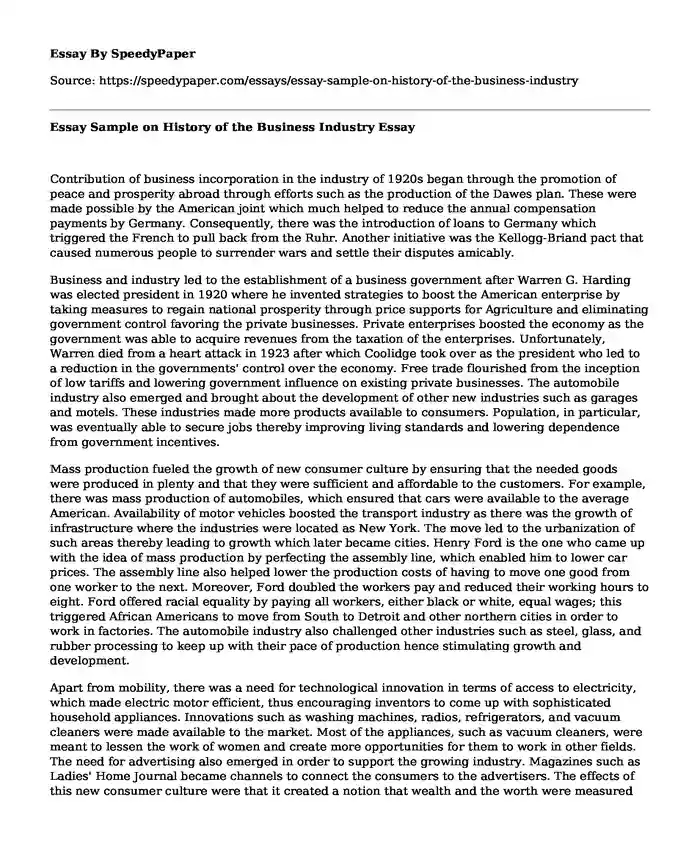Contribution of business incorporation in the industry of 1920s began through the promotion of peace and prosperity abroad through efforts such as the production of the Dawes plan. These were made possible by the American joint which much helped to reduce the annual compensation payments by Germany. Consequently, there was the introduction of loans to Germany which triggered the French to pull back from the Ruhr. Another initiative was the Kellogg-Briand pact that caused numerous people to surrender wars and settle their disputes amicably.
Business and industry led to the establishment of a business government after Warren G. Harding was elected president in 1920 where he invented strategies to boost the American enterprise by taking measures to regain national prosperity through price supports for Agriculture and eliminating government control favoring the private businesses. Private enterprises boosted the economy as the government was able to acquire revenues from the taxation of the enterprises. Unfortunately, Warren died from a heart attack in 1923 after which Coolidge took over as the president who led to a reduction in the governments' control over the economy. Free trade flourished from the inception of low tariffs and lowering government influence on existing private businesses. The automobile industry also emerged and brought about the development of other new industries such as garages and motels. These industries made more products available to consumers. Population, in particular, was eventually able to secure jobs thereby improving living standards and lowering dependence from government incentives.
Mass production fueled the growth of new consumer culture by ensuring that the needed goods were produced in plenty and that they were sufficient and affordable to the customers. For example, there was mass production of automobiles, which ensured that cars were available to the average American. Availability of motor vehicles boosted the transport industry as there was the growth of infrastructure where the industries were located as New York. The move led to the urbanization of such areas thereby leading to growth which later became cities. Henry Ford is the one who came up with the idea of mass production by perfecting the assembly line, which enabled him to lower car prices. The assembly line also helped lower the production costs of having to move one good from one worker to the next. Moreover, Ford doubled the workers pay and reduced their working hours to eight. Ford offered racial equality by paying all workers, either black or white, equal wages; this triggered African Americans to move from South to Detroit and other northern cities in order to work in factories. The automobile industry also challenged other industries such as steel, glass, and rubber processing to keep up with their pace of production hence stimulating growth and development.
Apart from mobility, there was a need for technological innovation in terms of access to electricity, which made electric motor efficient, thus encouraging inventors to come up with sophisticated household appliances. Innovations such as washing machines, radios, refrigerators, and vacuum cleaners were made available to the market. Most of the appliances, such as vacuum cleaners, were meant to lessen the work of women and create more opportunities for them to work in other fields. The need for advertising also emerged in order to support the growing industry. Magazines such as Ladies' Home Journal became channels to connect the consumers to the advertisers. The effects of this new consumer culture were that it created a notion that wealth and the worth were measured by how much appliances one had. The new culture also led to the expansion of businesses, where companies had to produce more in order to cater to the rising population.
Cite this page
Essay Sample on History of the Business Industry. (2023, Jan 29). Retrieved from https://speedypaper.net/essays/essay-sample-on-history-of-the-business-industry
Request Removal
If you are the original author of this essay and no longer wish to have it published on the SpeedyPaper website, please click below to request its removal:
- Free Essay Example on the Body Systems
- Worksheet On Radiation Essay Example
- Aviation Security Essay Sample from Our Database
- Free essay sample for students: Juan Mata's blog analysis
- Free Essay: Procurement Processes of Land Mark Computers and Risks to the Business
- Crusades and Islamic Sicily, Free Annotated Bibliography Sample
- Essay Sample on the Expression of Pride
Popular categories





